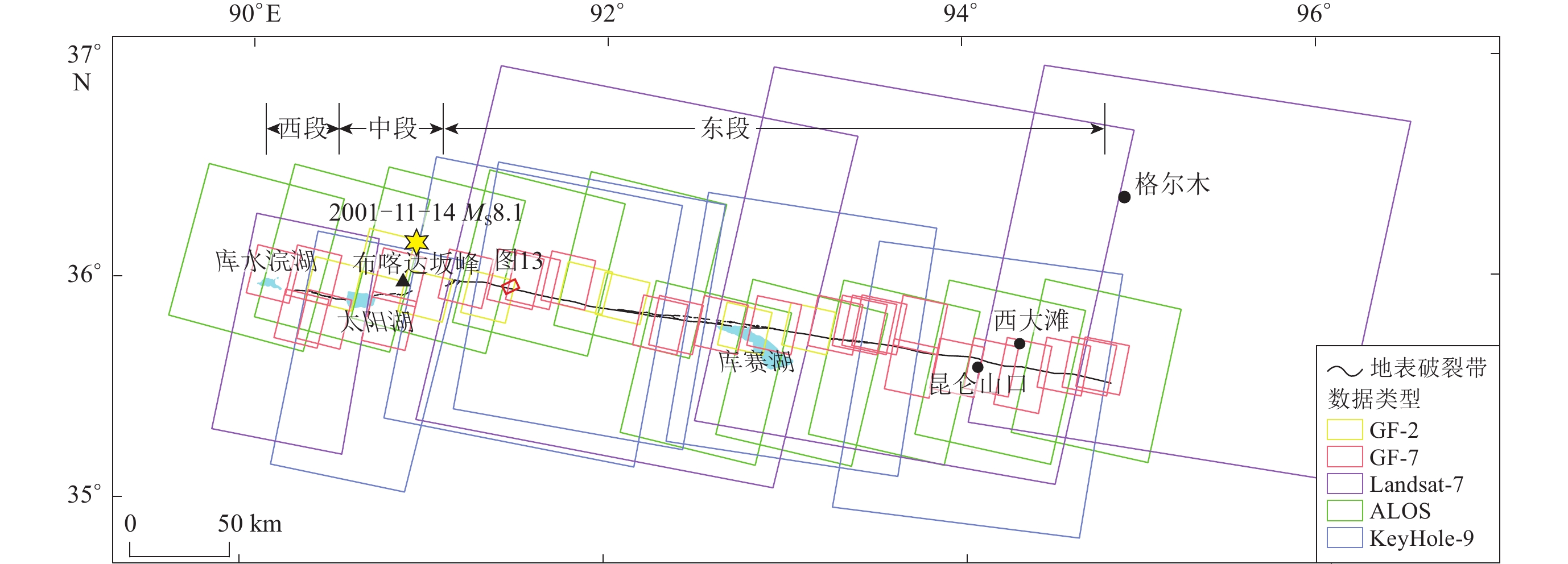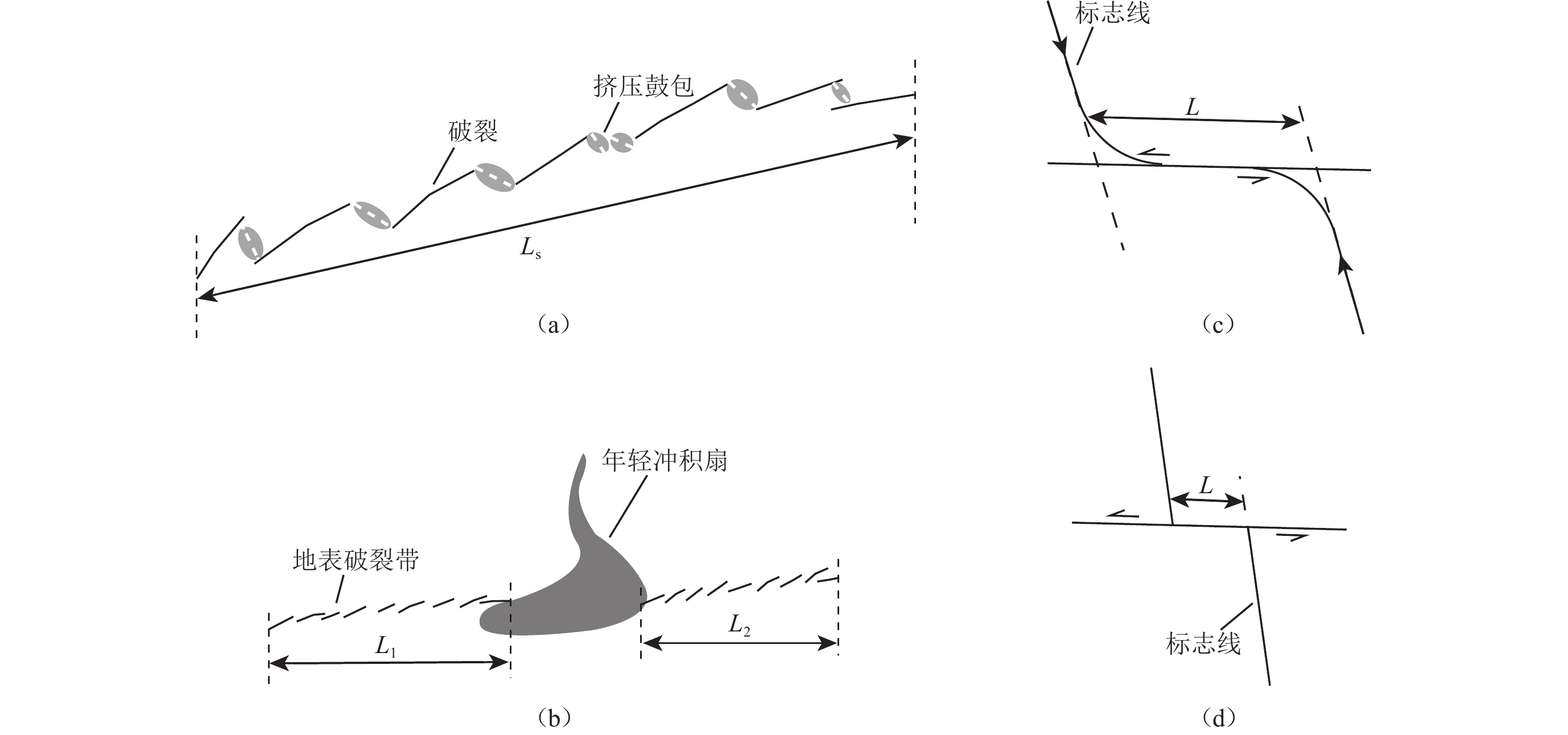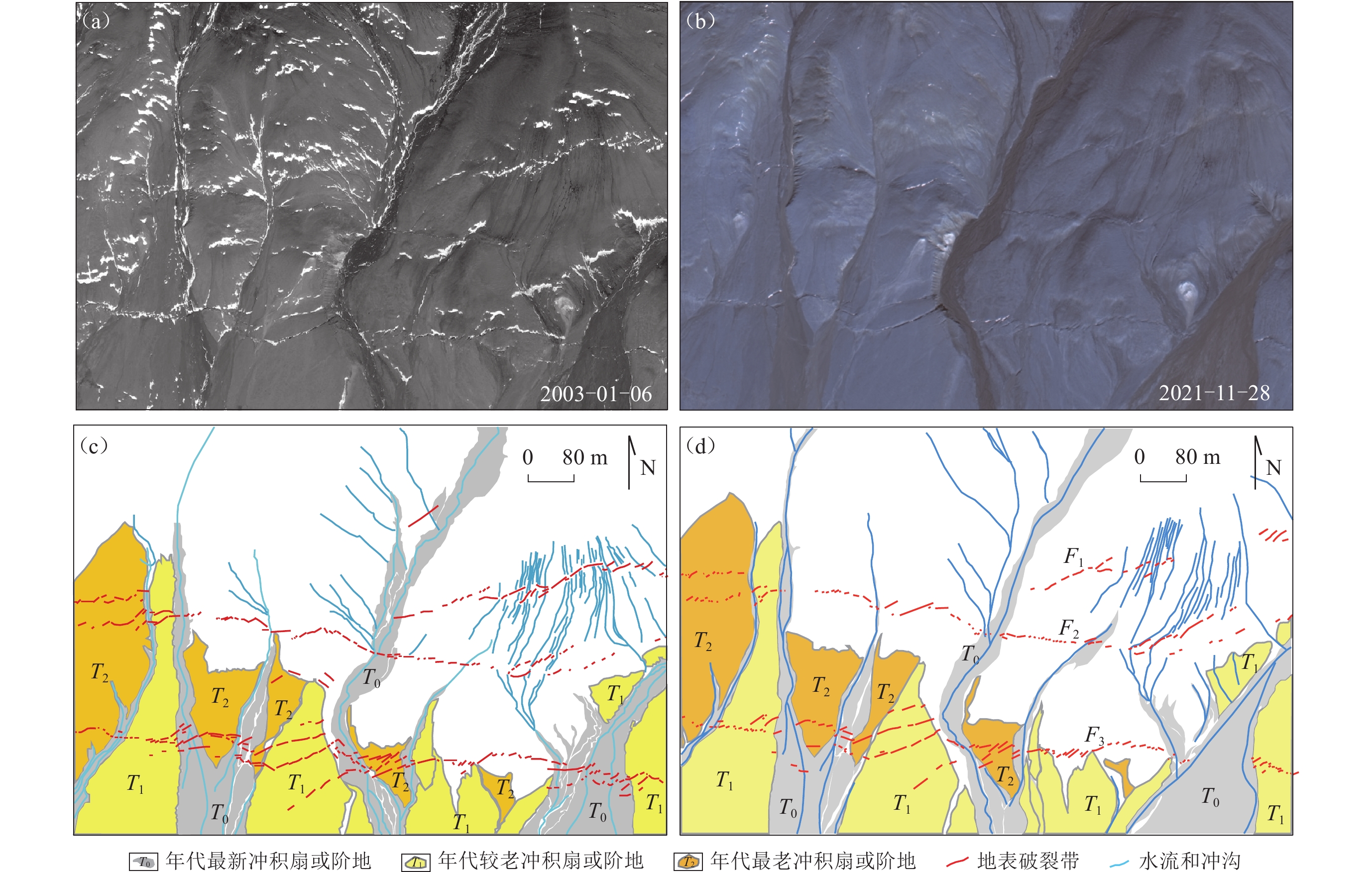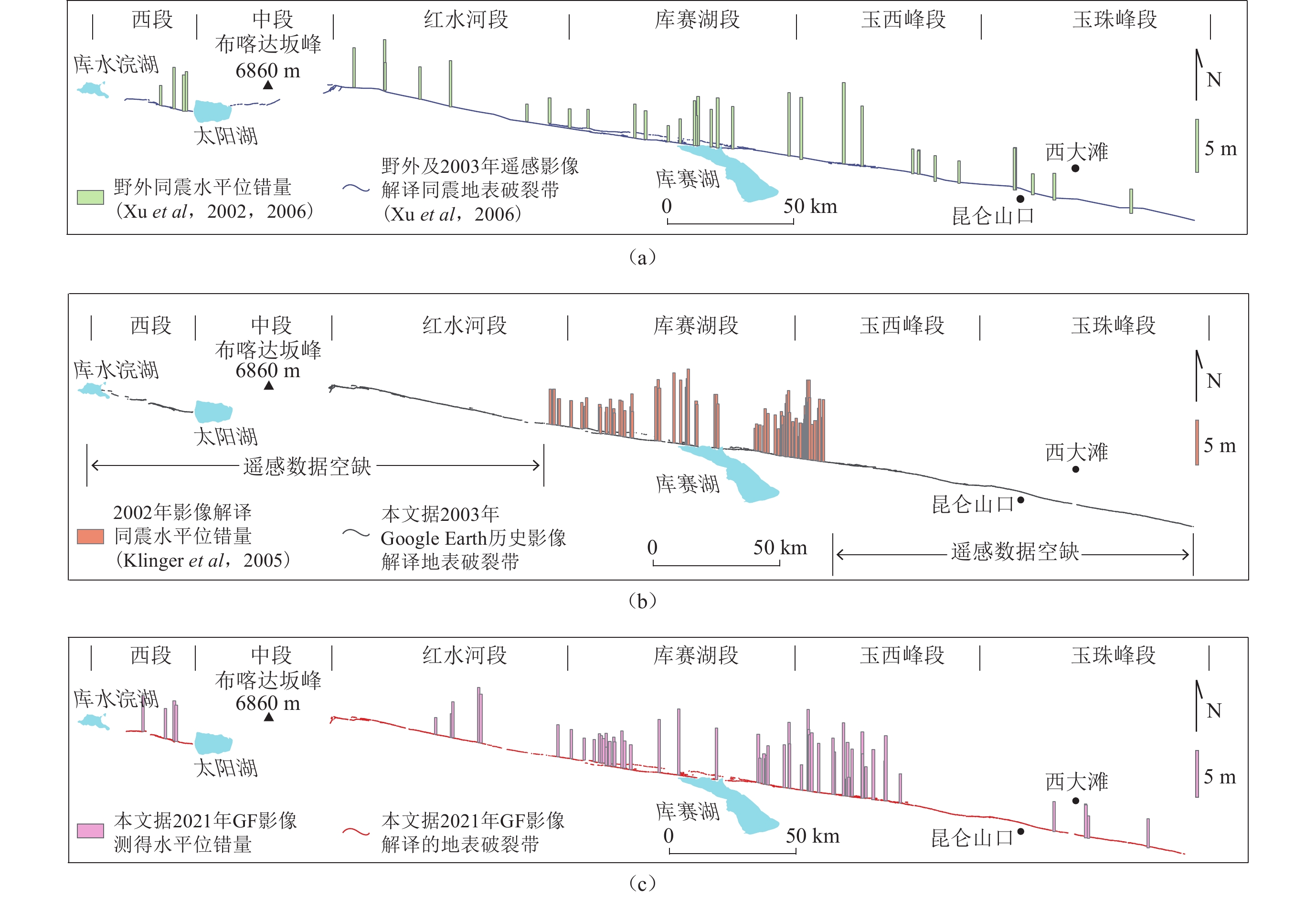Change identification of coseismic surface rupture zone over time based on multi-source satellite images:A casestudy of the west of Kunlunshan Pass MS8.1 earthquake in 2001
-
摘要:
基于震前、震后多期卫星数据,对2001年11月4日昆仑山口西MS8.1同震地表破裂进行了研究,结果表明:① 同震破裂带的西段在震前未发现先存破裂遗迹,而东段是在先存地震破裂遗迹上再次发生了破裂。② 震后两年,湖面冰、大型河道、冲沟和冲洪积扇上的地表破裂迅速地被活动性流水和气温变化等破坏,在影像上已无踪迹;震后二十年,低级阶地的地表破裂几乎无法识别,而高级阶地的破裂带保留较完整,可识别长度锐减至64%,呈“碎片”化展布。因此,同震地表破裂带的影像识别主要受所处地貌位置和气候变化等地表作用过程的影响,同时也受影像的空间分辨率及影像获取时间等因素的影响;而较老地貌面上保留的破裂带遗迹仍有助于开展历史地震、古地震地表破裂带的回溯研究。
-
关键词:
- 同震地表破裂带 /
- 昆仑山口西MS8.1地震 /
- 锁眼 /
- 高分卫星影像 /
- 地表过程
Abstract:Coseismic surface rupture is the permanent deformation on the surface in the middle and upper parts of the earth’s crust during a strong earthquake occurred. It indicates to a certain extent the deep structural characteristics of the active faults and the pre-existing tectonic environment , so complete extraction of characteristic of coseismic surface rupture has an important influence on the understanding of geometry and structure of the active faults.
On November 14, 2001, a West Pass of Kunlunshan earthquake with magnitude of MS8.1 occurred at Hoh Xil of no man’s land in Golmud City, Qinghai Province, northern Qinghai-Xizang Plateau. The instrumental epicenter was located near the Kunlun mountains at the junction of Xinjiang Uygur Autonomous Region and Qinghai Province within higher local altitude. The strong quake destroyed the Qinghai-Xizang Railway under construction and Qinghai-Xizang Highway connecting Xining to Lhasa, causing major economic losses to the country's lifeline projects. Due to the hypoxia, harsh natural environment, and inconvenient transportation of the epicenter area which difficult to conduct extensive field surveys. It is necessary to use high-resolution satellite archived images to study the time-varying characteristics of coseismic surface rupture induced by recent strong earthquakes, which has important reference significance for conducting research on historical strong earthquake events. This paper uses multi-temporal high-resolution satellite images (with resolution of 1−6 m) covering the coseismic surface rupture zone of the 2001 MS8.1 mainshock in the west of Kunlun Pass as the main research data to discuss the changes of coseismic surface rupture zone at different segments under natural surface process and check the reasons for its changes.
We select USGS KeyHole images with a spatial resolution of 6 m as pre-earthquake images, and the multi-period image data within 20 years post- earthquake from Google Earth (1 m), ALOS (10 m), Chinese GF-2 (1 m), and GF-7 (0.6 m). We use a comprehensive method of machine-assisted visual interpretation to extract the distribution of the coseismic rupture zone. The research results show that: ① A nearly 400 km linear coseismic surface rupture zone was formed during the 2001 earthquake, no pre-existing rupture remains were found in the relatively shorter western section before the earthquake, while the fresh coseismic rupture was reoccurrence along pre-existing earthquake ruptures at the longer eastern section. ② In 2003, two years after the earthquake, the coseismic surface ruptures locating at lake surface, crossing river valleys, gullies and alluvial fans which been checked during the earthquake field survey were rapidly affected by seasonal water flow and temperature (lake ice melt) changes. In 2011, 10 years after the earthquake, the surface rupture segments gradually showed a significant fragmented distribution on the images. Usually, continuous coseismic surface rupture zones can only be identified on high-level terraces or locations far away from active alluvial fans; in 2021, 20 years after the earthquake, coseismic surface ruptures on low-level terraces are almost impossible to identify, while the rupture zones on high-level terraces are relatively intact. The total length of identifiable rupture zones sharply reduced to 64%. More than 500 coseismic rupture sections had disappeared from the images during the past 20 years. ③ The measurement of coseismic horizontal dislocation based on GF image 20 years after the earthquake shows that the distribution of horizontal dislocation still has multiple peaks with maximum measured horizontal coseismic slip of 8.6 m, which is consistent with previous field survey but slightly smaller, and this proved that high quality satellite images can be used to combine the discontinuous coseismic rupture zone to together the length.
The identification of whole coseismic surface rupture zones on images is mainly affected by the surface processes. It is also affected by the spatial resolution of the images and their acquisition time. The identification of coseismic surface rupture of strong earthquakes can rely on emergency scientific surveys and satellite and aerial image data shortly after the earthquakes. However, the identification of surface rupture zones in uninhabited areas and historical strong earthquakes mainly relies on long-elapsed time and satellite imagery. Through residual rupture zone information on older landforms, it can recover more complete surface rupture zones than can be directly observed at the surface ground. Using satellite remote sensing images, scholars can restore the rupture scale of paleo-earthquakes and historical earthquakes, the surface rupture zone can be traced back through the residual rupture traces on older landforms, which is helpful in estimating the total length of the surface rupture zone, its magnitude, etc. Our research shows that the transformation process of coseismic surface ruptures induced by strong earthquakes can be understood in detail using multi-temporal high-spatial resolution images, which provides a methodological reference for exploring a large number of active faults within the Qinghai-Xizang Plateau to assess their earthquake risk in the future.
-
引言
同震地表破裂是发震断裂在地壳中上部发生破裂后在地表产生的永久变形,它在一定程度上指示了发震断裂的深部构造特征以及先存构造环境,对发震断层的几何学、运动学和动力学等方面的研究具有重要的指示作用。卫星遥感数据具有观测面积大、时效性强、分辨率高、获取方便和不受地面条件限制等优点(闫世勇,2009;魏永明等,2021),能够很大程度地减少自然或人为条件对野外调查工作造成的限制。随着遥感技术的不断发展,20世纪末就有外国学者利用遥感数据对地震所产生的各种地表形变进行研究(Crippen et al,1992;Michel et al,1999);进入21世纪后,国内外开始涌现出大量与遥感技术相关的地震形变研究(Fu et al,2005;Klinger et al,2005;Xu et al,2006,2008;付碧宏等,2008;陈桂华,2010;Lin et al,2003;McCalpin,2009;刘静等,2023)。利用卫星遥感存档数据研究现今强震破裂带随时间变化的特征,对开展历史地震破裂研究具有重要意义。
2001年11月14日,青海省格尔木市发生MS8.1地震(以下称为昆仑山口西MS8.1地震),仪器震中位于青藏高原北缘新疆与青海交界的昆仑山附近(36.2°N,90.9°E)(徐锡伟等,2002)。由于破裂区的海拔高、空气稀薄、自然环境恶劣且交通不便,使得利用传统的野外考察方法来研究同震地表破裂带存在一定困难,因此遥感技术在此次地震研究中发挥了重要作用。本文以2001年昆仑山口西MS8.1同震地表破裂带在高分辨率卫星影像上随时间的变化为例,拟讨论在自然条件下、不同离逝时间段内的卫星影像中走滑型同震地表破裂带的可识别程度及其变化原因,以期为历史和现今强震震例地表破裂带的完整性遥感解译提供案例支持,为综合利用多源遥感数据开展震例解剖提供方法参考。
1. 研究区概况
东昆仑断裂带是沿着昆仑山南缘发育的一组WNW至EW向左旋走滑的断裂带,全长约2 000 km,北部为柴达木地块,南部为巴颜喀拉地块,它调节着青藏高原向东挤出产生的应变,与高原的隆升、演化、新构造运动和强震活动等有着十分密切的关系,是高原内部一条重要的活动构造带(Avouac,Tapponnier,1993;Meyer et al,1998;青海省地震局等,中国地震局地壳应力研究所,1999;Zhang et al,2004)。van der Woerd等(2000)根据地质学方法计算得到东昆仑断裂带40 ka以来的平均滑动速率为(11.5±2.0) mm/a,与GPS观测得到的速率值约10—12 mm/a一致(Zhang et al,2004),较高的滑动速率与极强的地震活动性使该断裂带一直备受关注。
昆仑山口西MS8.1地震是有历史记录以来发生在东昆仑断裂带上地表破裂规模最大的一次地震事件,它破坏了连接西宁至拉萨的青藏铁路、青藏公路,造成我国生命线工程的重大经济损失。本次地震震中位于布喀达坂峰西北,其同震地表破裂带沿昆仑山南缘的第四纪冲洪积扇发育,该地区平均海拔4 500 m以上,是典型的高原高寒气候区,全年降水量较少,主要集中在七八月份,水源的主要补给源为高山积雪和冰川融水。同震地表破裂带西起库水浣湖东岸,东至昆仑山口以东约70 km处的玉珠峰南缘(图1),全长超过400 km,由剪切破裂、张剪切破裂、张性破裂、挤压鼓包和地震陡坎等破裂单元组成(Lin et al,2003;Antolik et al,2004;Klinger et al,2005;Tocheport et al,2006;Xu et al,2006,2008)。不同学者运用地震地质学和地球物理学的方法对同震地表破裂带作了详细研究,结果显示:同震地表破裂带在空间上自西向东可分为西段、中段、东段,并分别对应3次地震子事件,表明此次地震的发震机制较为复杂(图1)。西段从太阳湖湖面延伸至库水浣湖东岸,长约64 km,为纯左旋滑动段,平均左旋滑动量为1—3 m (赵瑞斌等,2002;Fu et al,2005);中段为连接破裂带西段和东段的大型伸展阶区,该段长45 km,中段内破裂几乎没有到达地表(Antolik et al,2004);东段是2001年地震的主破裂段,长度超过350 km,根据几何学特征又将其分为红水河段、库赛湖段、玉西峰段和玉珠峰段,每条次级破裂带都存在一个位移峰值,同震水平位错量从峰值向两侧递减,平均水平位移3—6 m,最大水平位移出现在玉西峰段,长达8 m (Xu et al,2006,2008)。同震地表破裂带在红水河口西侧分叉为南北两支,北支表现为一系列具有倾滑性质的正断层陡坎,南支表现为左旋走滑性质的破裂带,King等(2005)将这种几何结构解释为断裂在深部的传播速度大于地表附近的传播速度而产生的滑动分割。
2. 数据和研究方法
2.1 遥感数据及处理方法
本文使用5景KeyHole数据用于2001年震前先存构造迹线的解译;5景Landsat数据作为对其它数据类型产生空缺时的补充;96景Google Earth历史影像作为震后两年内地表破裂带变化特征分析的数据源,在缺少影像的地点使用空间分辨率为15 m的Landsat影像作为补充;10景ALOS影像用于分析地表破裂带震后10年在中分辨率影像上的变化特征;27景GF-7影像用于提取地表破裂带在震后20年的卫星遥感影像上的变化特征,在未能完整覆盖的区域使用8景GF-2影像加以补充(表1、图2)。同震地表破裂带的现场调查结果则参考已公开发表的前人研究成果。
表 1 文章所使用的卫星遥感数据参数Table 1. Satellite remote sensing data parameters used in this paper遥感数据类型 最高分辨率/m 景数 影像采集年份 解译用途 KeyHole-9① 6 5 1 973—1 980 震前 Landsat-7① 15 4 1 999—2 002 震前、震后补充 Google Earth 0.33 96 2 002—2 003 震后两年 ALOS② 10 10 2 007—2 010 震后10年 GF-7③ 0.76 27 2 021—2 022 震后20年 GF-2③ 1 8 2 021—2 022 震后20年 注:① 数据引自United States Geological Survey (2 021);② 数据引自National Aeronautics and Space Administration (2 022);③ 数据引自中国航天科技集团有限公司(2 022)。 遥感数据的前处理主要应用ArcGIS 和ENVI软件。在ArcGIS中添加控制点进行地理配准处理,使图片转化为具有空间坐标的影像,然后再进行裁剪和镶嵌等处理;ALOS卫星的原始数据为具有空间坐标信息并包含多光谱和全色影像的数据集,仅需在ArcGIS软件中将多波段图像进行RGB合成处理,得到假彩色合成影像;GF系列影像在ENVI软件中进行RPC正射校正和多光谱及全色影像融合,融合后彩色GF-7影像空间分辨率为0.76 m、GF-2影像分辨率1 m。本文统一在比例尺为1 ∶ 1 500的地图上进行遥感影像的地表破裂带识别工作。
2.2 地表破裂带的影像长度及位移测量方法
前人野外实际调查工作中对地表破裂带及同震位移的测量方法(陈杰等,2004)同样适用于遥感影像上的地表破裂带长度及同震位移测量,结合研究中遇到的情况总结两种在卫星影像上测量地表破裂带长度的模式:① 张性破裂、张剪切破裂、剪切裂缝或挤压鼓包呈左阶或右阶雁列状连续排列,则破裂的起始点和终点之间的距离Ls即为遥感影像上地表破裂带的总体长度,如图3a所示;② 原本连续的地表破裂带随时间变化在影像上呈“碎片状”分布,则可识别的总体长度应该减去破裂带经过的被遮挡的破裂段。如图3b所示,地表破裂带总体长度L=L1+L2。在测量水平位移过程中主要也存在两种情况:① 被断错的标志线在远离断错面处呈直线状,但在断错面附近有一定的弯曲,为确认这种弯曲仅为2001年MS8.1地震造成的,结合震前KeyHole影像,尽可能选择震前无明显弯曲的标志线进行水平位移的测量,L即为影像上可测量的水平位错量(图3c);② 被断错标志线呈直线状,且在断错面两侧无明显变形,那么标志线上两断点之间的距离L即为影像上可测量的水平位移,如图3d所示。
![]() 图 3 地表破裂带长度及水平位移测量方式示意图(修改自陈杰等,2004)(a) 连续地震破裂带长度测量方法;(b) “碎片状”地震破裂带长度测量方法;(c) 标志线两侧产生弯曲变形的位移测量方法;(d) 未变形标志线的测量方法Figure 3. Schematic diagram of the measurement method of the length and horizontal displacement of surface rupture zone (modified from Chen et al,2004)(a) Methods of measuring the length of successive surface ruptures;(b) Methods for measuring the length of “fragmentary” surface ruptures;(c) The displacement measurement method for marking line with bending deformation;(d) Method of measuring undeformed mark lines
图 3 地表破裂带长度及水平位移测量方式示意图(修改自陈杰等,2004)(a) 连续地震破裂带长度测量方法;(b) “碎片状”地震破裂带长度测量方法;(c) 标志线两侧产生弯曲变形的位移测量方法;(d) 未变形标志线的测量方法Figure 3. Schematic diagram of the measurement method of the length and horizontal displacement of surface rupture zone (modified from Chen et al,2004)(a) Methods of measuring the length of successive surface ruptures;(b) Methods for measuring the length of “fragmentary” surface ruptures;(c) The displacement measurement method for marking line with bending deformation;(d) Method of measuring undeformed mark lines2.3 地表破裂带的影像识别标志
利用光学遥感影像对地物进行解译和识别主要通过影像的色调、色彩、大小、形状、阴影、纹理、相对空间关系等特征来判读目标对象及其属性(梅安新等,2001)。因此,要想通过遥感影像准确获得地表破裂带的变形信息,需要建立地表破裂带的对应影像识别标志。由于受到剪切作用,走滑型地表破裂带有独特的几何形态和展布特点,张性破裂、张剪切破裂、剪切破裂通常呈羽列或雁列状沿着特定的走向分布,而挤压鼓包往往发育在两条地震裂缝之间与裂缝首尾相连相间排列。通过影像上的阴影、纹理排列和形状变化可以识别各类地震裂缝(图4a);通过形状、阴影及分布位置可以识别挤压鼓包(图4a),通过不同的颜色变化识别断塞塘(图4b);此外,通过影像形状、纹理识别地貌标志的同震位移,如被断错的河道、阶地、冲沟(图4c)。
![]() 图 4 昆仑山口西同震地表变形的典型识别标志(a) 地震裂缝在影像上的阴影和纹理特征和挤压鼓包在影像上的形状和阴影特征;(b) 断塞塘在影像上的颜色变化;(c) 被断错的冲沟在影像上的形状变化Figure 4. Typical identification signs of surface deformation in the West Kunlunshan Pass earthquake(a) The shadow and texture features of seismic cracks on the image,and the shape and shadow features of mole-track on the image;(b) The colour change of the sag pond on the image;(c) The shape change of the dislocated gully on the image
图 4 昆仑山口西同震地表变形的典型识别标志(a) 地震裂缝在影像上的阴影和纹理特征和挤压鼓包在影像上的形状和阴影特征;(b) 断塞塘在影像上的颜色变化;(c) 被断错的冲沟在影像上的形状变化Figure 4. Typical identification signs of surface deformation in the West Kunlunshan Pass earthquake(a) The shadow and texture features of seismic cracks on the image,and the shape and shadow features of mole-track on the image;(b) The colour change of the sag pond on the image;(c) The shape change of the dislocated gully on the image2.4 多空间分辨率数据来源的融合分析
魏永明等(2021)指出地表破裂基本单元、组合特征及其破裂规模的遥感识别程度和精度与光学遥感影像数据类型及空间分辨率有直接关系。针对走滑型地震,中分辨率(15—30 m)遥感影像可识别其地表破裂带的空间延伸方向和累积破裂规模,但无法识别破裂的基本单元;5 m以上分辨率的遥感影像可清晰地识别出整体地表破裂带、规模较大的单个地震裂缝(宽度超5 m)及拉分盆地,也较易识别出规模较大的断错水系,但不易识别出挤压鼓包;空间分辨率为1—5 m的光学遥感影像可以利用线性纹理和阴影特征识别坡度较陡、规模较大、整体连续的断层陡坎,以及走滑型地表破裂带的平面组合、地震裂缝、拉分盆地、断塞塘、水平断错水系及地物、大型挤压鼓包等;亚米级遥感数据可识别走滑型地震的几乎所有单个破裂类型及平面组合特征以及地震陡坎线性行迹。结合昆仑山口西地震的地表破裂规模与本文所使用的光学遥感数据对比分析显示:15 m分辨率的Landsat-7影像仅能够识别出昆仑山口西地表破裂带的大致位置和空间延伸方向;10 m分辨率的ALOS影像可识别出地表破裂带的位置、延伸方向和大致规模以及部分具有多次累积的挤压构造;KeyHole-9影像可清晰地识别出先存的构造迹线及同震地表破裂遗迹;1 m至亚米级的高分卫星影像和Google Earth影像中的纹理、阴影、形状和颜色特征可清晰地显示出各类地震裂缝、挤压鼓包和断错地貌标志,在识别破裂带迹线变化工作中发挥了重要作用。
3. 结果分析
3.1 昆仑山口西MS8.1同震地表破裂遗迹解译
通过解译成像时间在1973—1980年的KeyHole-9影像,发现在布喀达坂峰至西大滩以东,断裂的线性特征十分明显,大致走向为N80°W,线性构造控制了地貌单元的边界,北侧为绵延的昆仑山脉、南侧为平坦的山前冲积扇(图5a)。研究区内存在两种先存构造迹线,一种在遥感影像上表现为深灰色或亮白色的、极窄的线性纹理(图5b);另一种则表现为具有一定宽度的暗色条带(图5c)。第一种构造迹线应为历史地震或古地震活动所产生的地表破裂带遗迹,暗示了区域历史地震、古地震事件,将其称为地震破裂遗迹(图5d);第二种构造迹线为区域内断裂运动的产物,但并不能简单地将其判定为晚第四纪活动断层运动的结果。
![]() 图 5 1973—1980年KeyHole影像及地震破裂遗迹解译结果(a) 震前KeyHole影像;(b) 多级阶地上的同震地表破裂遗迹;(c) 暗色条带状的先存构造迹线;(d) 地震破裂遗迹分布图Figure 5. Interpretation results of earthquake rupture remains using KeyHole images during 1973−1980(a) Pre-earthquake KeyHole image;(b) Earthquake surface rupture remains on multistage terrace;(c) Dark banded preexisting structural trace;(d) Earthquake rupture trace distribution map
图 5 1973—1980年KeyHole影像及地震破裂遗迹解译结果(a) 震前KeyHole影像;(b) 多级阶地上的同震地表破裂遗迹;(c) 暗色条带状的先存构造迹线;(d) 地震破裂遗迹分布图Figure 5. Interpretation results of earthquake rupture remains using KeyHole images during 1973−1980(a) Pre-earthquake KeyHole image;(b) Earthquake surface rupture remains on multistage terrace;(c) Dark banded preexisting structural trace;(d) Earthquake rupture trace distribution map昆仑山口西MS8.1地震发生前,在太阳湖以西并未观察到明显的同震地表破裂遗迹,但在黑驼峰北侧的山前发育一系列WNW走向的大型挤压构造,表明区域内曾存在断裂活动;MS8.1地震的地表破裂带在该段内并未按照先存构造迹线展布。太阳湖东岸至布喀达坂峰东南侧之间未发现任何断层及地震活动的痕迹。布喀达坂峰以东,先存构造迹线沿着昆仑山南缘的山脚展布,控制着山前冲洪积扇的分布;沿着山前冲洪积扇的后缘发育大量的地震破裂遗迹,影像上呈深灰色线性纹理且在水流经过处不连续(图5b),2001年昆仑山口西MS8.1同震地表破裂带沿着这些先存破裂迹线重新破裂。通过遥感影像可以观察到红水河口西侧冲积平原上存在明显的先存破裂,呈近EW向的深灰色线条切过多条冲沟,不同等级的冲沟显示出不同的累积左旋位错量,表明早在昆仑山口西MS8.1地震发生前此处已发生过不止一次左旋走滑地震(图5b),库赛湖西侧的影像上表现为穿过断裂带的不同级别的河流的河床出现数十米甚至更大的左旋位错量,这是多次地震位错量累计的结果。在库赛湖两侧发育一系列古地震活动遗迹,如拉分盆地、挤压鼓包和断塞塘等。地震破裂遗迹从玉西峰山前穿过,影像上呈亮白色线条,沿线地貌标志线发生明显的左旋错动,不同规模的河道及冲沟具有不同的累积位错量。从昆仑山口往东,地震破裂遗迹沿着玉西峰南麓向东延伸了约70 km。
3.2 昆仑山口西MS8.1地震震后两年内破裂带的影像解译
昆仑山口西MS8.1地震震后两年的卫星影像上,在太阳湖西岸,地表破裂带主要由张剪切破裂、剪切破裂、挤压鼓包及地震塌陷组成,呈左阶或右阶雁列式排列(图6a)。地表破裂带由右阶斜列的几条次级破裂带组成,从太阳湖西岸一直延伸至库水浣东岸,整体走向WNW。在布喀达坂峰东南角,昆仑山口西MS8.1地震的地表破裂带呈NE向马尾状分布,切割了古老冰碛物和年轻河道,随后以WNW向沿着昆仑山脚下的第四纪冲洪积扇继续向东延伸(图6b)。红水河口以东地表破裂带分为南北两支,北支显示出倾滑性质,南支表现为左旋走滑,但北支在影像上的线性特征并不明显(图6c)。地表破裂带在玉西峰南侧山脚分为多条右阶斜列状的次级破裂带(图6d),每条次级破裂进一步由斜列的地震裂缝和挤压鼓包组成,地表线性延伸强。昆仑山口以东约70 km处地表破裂带的迹线在影像上开始模糊直至消失。
![]() 图 6 震后两年(2003年)同震地表破裂带的影像特征(a) 太阳湖西侧地表破裂的组合特征;(b) 东段西端点的马尾状分叉;(c) 红水河口东侧的南北两支地表破裂带;(d) 玉西峰段右阶排列的次级破裂带。箭头指示断裂走向Figure 6. Image characteristics of coseismic surface rupture zone in 2003,two years after the 2021 earthquake(a) Combined characteristics of surface rupture on the west side of the Sun Lake;(b) Horsetail bifurcation at the west end of the eastern segment;(c) Surface rupture zones in the north and south branches east of the Hongshui River Pass;(d) Right-step secondary surface rupture zone at Mount Yuxi segment. The arrows indicating the srtike of active fault
图 6 震后两年(2003年)同震地表破裂带的影像特征(a) 太阳湖西侧地表破裂的组合特征;(b) 东段西端点的马尾状分叉;(c) 红水河口东侧的南北两支地表破裂带;(d) 玉西峰段右阶排列的次级破裂带。箭头指示断裂走向Figure 6. Image characteristics of coseismic surface rupture zone in 2003,two years after the 2021 earthquake(a) Combined characteristics of surface rupture on the west side of the Sun Lake;(b) Horsetail bifurcation at the west end of the eastern segment;(c) Surface rupture zones in the north and south branches east of the Hongshui River Pass;(d) Right-step secondary surface rupture zone at Mount Yuxi segment. The arrows indicating the srtike of active fault地震裂缝和挤压鼓包是本次昆仑山口西MS8.1地震中分布最广泛的地表破裂单元。在震后两年的影像上,大部分张性破裂受风力及流水堆积作用被砂土、砾石等充填而无法清晰识别;而一部分张性破裂被雨水或其它水源充填而形成小型的水塘,从而表现出与地表截然不同的光谱特征,十分易于识别;剪切破裂和张剪切破裂通常受外力改造程度较低,在影像上的变化程度较小,易于被识别(图6a)。挤压鼓包是走滑型地表破裂最主要的破裂类型之一,包括由于冻土变形产生的角脊型鼓包和由于未固结地层变形产生的凸起型鼓包。震后短时间内角脊型鼓包在影像上显示为边界清晰、棱角尖锐的形态特征,随着气温回升顶部冻土层融化角脊型鼓包开始坍塌,其隆起边界与周围地形边界变得模糊不清,在卫星影像上通常只能保持到次年春季气温回升之前。因此,无法从研究区2003年的影像上识别出角脊型挤压鼓包。凸起型鼓包虽同样受到一定的流水及风力等自然侵蚀,但这些外力作用对其在地表具体的形态特征的影响不大(图6a)。
与前人研究结果(Fu et al,2005;Xu et al,2006)对比(图7):① 原本发育在库水浣湖、太阳湖及库赛湖冰面上的地表破裂带在2003年已无法辨识(图7a,b)(Fu et al,2005),原因是春季气温回升、冰面融化使得地表破裂带也随之消失;② 在影像上并未识别出中段的地表破裂带(图7a,c)(Xu et al,2006),可能是由于该段地表破裂规模较小且分布不连续,导致在空间分辨率有限的遥感影像上难以识别;③ 库赛湖段存在南北两支地表破裂带(图7f),但在2003年研究区遥感影像上并未识别出完整的两支地表破裂带(图7d),这是由于在库赛湖以北缺少可使用的高分辨率数据;④ 东段的解译结果整体与前人相似(图7e,f),影像上不能识别出地表破裂带的地点多集中在大型现代河道、低级冲洪积扇和冲沟附近(图7d),大型现代河道、冲洪积扇和年轻的冲沟上水流活动频繁,较大的冲刷和堆积能力导致地表破裂带被冲刷侵蚀或被沉积物掩埋从而无法在影像上识别。
3.3 昆仑山口西MS8.1地震震后十年破裂带的影像解译
通过10 m分辨率的ALOS影像发现:震后十年,影像上显示的地表破裂带整体的可识别程度较高,小比例尺上的破裂带分布基本遵循同震地表破裂带的空间分布特点(图8a,b),较低的空间分辨率导致红水河至库赛湖之间的破裂带无法被完整识别(图8b)。大比例尺图像上,地表破裂带被大型的山前冲积扇、冲沟、河流和年轻的河流阶地分割成无数条不连续的线段,呈现出“碎片”化的分布特点(图9);通常只在高级阶地(图9a,b)或远离大型冲积扇和冲沟(图9c,d)的地点才能够识别出连续的地表破裂带。
![]() 图 9 典型地貌点地表破裂带的ALOS影像(左)及解译(右)(a−b) 红水河西侧的多级阶地上的地表破裂带;(c−d) 玉西峰南缘的冲积扇和地表破裂带Figure 9. ALOS image and interpretation of surface rupture zone at typical geomorphic points(a−b) Surface fracture zone distribution on multilevel terrace on the west side of Hongshui River;(c−d) Alluvial fan and surface rupture zone distribution at the southern margin of Yuxifeng
图 9 典型地貌点地表破裂带的ALOS影像(左)及解译(右)(a−b) 红水河西侧的多级阶地上的地表破裂带;(c−d) 玉西峰南缘的冲积扇和地表破裂带Figure 9. ALOS image and interpretation of surface rupture zone at typical geomorphic points(a−b) Surface fracture zone distribution on multilevel terrace on the west side of Hongshui River;(c−d) Alluvial fan and surface rupture zone distribution at the southern margin of Yuxifeng3.4 昆仑山口西MS8.1震后二十年破裂带的影像解译
在昆仑山口西MS8.1震后二十年即2021年研究区的影像上(图10),库水浣湖一侧已无法识别出地表破裂带,红水河与库赛湖之间仍可识别出两段地表破裂带和一系列裂缝。在小比例尺的影像图上,地表破裂带整体连续(图10b);在大比例尺的影像图上地表破裂带的纹理特征及阴影特征都减弱,且空间分布特征也变得离散(图11和图12)。
![]() 图 11 图10中地点1的地表破裂带影像及解译图图(a)和(c)为IKONOS图像(2002-01)及解译(Li et al,2005);图(b)和(d)为GF-7图像(2021-10-10)及解译Figure 11. Image and interpretation of surface rupture zone at site 1 on Fig.10Figs.(a) and (c) are IKONOS images (2002-01) and interpretation results (according to Li et al,2005);Figs.(b) and (d) are GF-7 images (2021-10-10) and interpretation results
图 11 图10中地点1的地表破裂带影像及解译图图(a)和(c)为IKONOS图像(2002-01)及解译(Li et al,2005);图(b)和(d)为GF-7图像(2021-10-10)及解译Figure 11. Image and interpretation of surface rupture zone at site 1 on Fig.10Figs.(a) and (c) are IKONOS images (2002-01) and interpretation results (according to Li et al,2005);Figs.(b) and (d) are GF-7 images (2021-10-10) and interpretation results![]() 图 12 地点2处地表破裂带影像(上)及解译(下)图图(a),(c)为2003-01-06的IKONOS图像及解译(修改自Xu et al,2006);图(b),(d)为2021-11-28的 GF-7图像及解译Figure 12. Image and interpretation of surface rupture zone at site 2Figs.(a),(c) are IKONOS images (2003-01-06) and interpretation results (modified from Xu et al,2006);Figs.(b),(d) are GF-7 images (2021-11-28) and interpretation results
图 12 地点2处地表破裂带影像(上)及解译(下)图图(a),(c)为2003-01-06的IKONOS图像及解译(修改自Xu et al,2006);图(b),(d)为2021-11-28的 GF-7图像及解译Figure 12. Image and interpretation of surface rupture zone at site 2Figs.(a),(c) are IKONOS images (2003-01-06) and interpretation results (modified from Xu et al,2006);Figs.(b),(d) are GF-7 images (2021-11-28) and interpretation results在红水沟的多级阶地上(35.894°N,92.158°E;图10中地点1),距离红水河口西侧约8 km处,Li等(2005)利用震后两个月的IKONOS影像测量断错地貌得到了本次地震的同震位移和大量累积位移。同震地表破裂带在影像上呈一条N75°W的黑色条带,与周围形成明显的对比,断错了T0—T4阶地和多条冲沟,较老的阶地和冲沟左旋错动明显,反映了该地的古地震事件,地表破裂性质主要为多条交错重合的张性、张剪切破裂(图11a,c);在研究区内2021年的影像上,地表破裂带的线性特征明显,但破裂细节较模糊,从影像上无法清晰地判断具体的破裂类型,年代较老的阶地上的累积断错量明显较大(图10d,11b)。发育在年代较老的T3,T4阶地上的地表破裂带的形态保存良好,基本可以识别出完整的地表破裂带形迹;较为年轻的T1,T2阶地上,地表破裂带形态模糊、断续,仅可以识别出一部分地表破裂带;而在最年轻的T0阶地上已无法识别出地表破裂带(图11d)。
在玉西峰段的中部(35.764°N,93.362°E;图10中地点2),Xu等 (2006)在此利用1 m分辨率的IKONOS影像对其进行了详细解译。IKONOS影像显示此处的同震地表破裂带形态复杂,可分为相距100 m左右的3条次级破裂带(F1—F3)(图12d);3条EW向的次级破裂带又由单条走向约NE30°—45°的羽列状张剪切破裂组合而成(图12a)。地表破裂带断错了T0—T3阶地和一系列密集分布的小型冲沟,由于覆盖少量积雪导致在影像上极易识别(图12c)。地表破裂带在2021年的影像上清晰可见,F3在影像上最明显,可以识别出地表的雁列状张剪切破裂,F1最为模糊(图12b)。地表破裂带在T0阶地和冲沟密集发育的地点被破坏程度最高(图12d),表明流水作用对跨河流地表破裂带的破坏较为强烈。
图13分别显示了研究区2003年、2017年和2021年三个时间段上破裂带的三维影像特点,不同时间段的昆仑山口西MS8.1地震破裂带总体形态连续,但在2021年的影像上山前出现了多个河流的河床或低级阶地上破裂带不可识别的现象(图13c),破裂带呈现明显的“碎片”化展布特征。尽管这些不可识别的破裂带均长度较短,但数量较多。且的确导致了破裂带的不完整性。
![]() 图 13 三维场景下不同时间的地表破裂带的影像展布特征(a) 地表破裂带切断河流与各级冲沟;(b) 河流与部分冲沟上无法识别地表破裂带;(c) 河流与冲沟上无法识别的地表破裂带,图中序号表示地表监测点,序号后括号内数字表示无法识别的地表破裂带长度Figure 13. Characteristics of surface fracture zones over time in a three-dimensional scene,noting gradual fragmentation(a) Surface rupture zones cutting off rivers and gullies;(b) Surface rupture zones could not be identified on rivers and some gullies;(c) Surface rupture zones that cannot be identified on rivers and gullies。The serial numbers represent the local surface monitoring sites and the number after the serial number indicates the length of the surface rupture zone that cannot be identified
图 13 三维场景下不同时间的地表破裂带的影像展布特征(a) 地表破裂带切断河流与各级冲沟;(b) 河流与部分冲沟上无法识别地表破裂带;(c) 河流与冲沟上无法识别的地表破裂带,图中序号表示地表监测点,序号后括号内数字表示无法识别的地表破裂带长度Figure 13. Characteristics of surface fracture zones over time in a three-dimensional scene,noting gradual fragmentation(a) Surface rupture zones cutting off rivers and gullies;(b) Surface rupture zones could not be identified on rivers and some gullies;(c) Surface rupture zones that cannot be identified on rivers and gullies。The serial numbers represent the local surface monitoring sites and the number after the serial number indicates the length of the surface rupture zone that cannot be identified4. 讨论
4.1 地表破裂带在卫星影像上的时空演变及影响因素
2001年昆仑山口西MS8.1同震地表破裂带在不同时期影像上的可识别特点表现为:震后两年,在卫星影像中未能识别出大型现代河道、冲沟和冲积扇上的地表破裂带;湖泊冰面上发育的同震地表破裂带也随着气温的升高和冰面一起消失在影像上;由于冻土变形产生的角脊型鼓包在气温回升后坍塌,影像特征发生变化从而不易在影像上识别到;其余地点的地表破裂带及其基本单元保存完整,形态特征变化较小,这一时期影响地表破裂带变化的主要因素是温度和流水等外力作用。震后十年,地表破裂带特征表现为整体呈现出“碎片”化的分布(图13),能够在高级阶地和远离河流、冲沟、冲积扇的地点的影像上识别出更完整的破裂带;影响这一时期同震地表破裂带空间分布的因素主要是高原高寒地区季节性流水的地表作用;同时ALOS影像的分辨率较低导致了对这一时期的地表破裂带识别不完整。震后二十年,年代较老的T3,T4阶地上地表破裂带的可识别程度较高,在部分高级阶地上可以清晰地识别地表破裂带的具体破裂类型或组合特征;在较年轻的T1,T2阶地上地表破裂带形态模糊,能识别出一部分破裂带但很难通过影像判断具体的破裂单元;在最年轻的T0阶地的大部分位置都无法识别出破裂带,根据影像上可识别的地表破裂带分布判断,这一时期流水的冲刷侵蚀和堆积作用是破坏地表破裂带形态及分布的主要原因。
在卫星遥感影像上无法识别同震地表破裂带的情况主要包含两种:① 影像上不能识别破裂带的地点,因实际上已没有地表破裂带分布。其原因是,随着局部地貌和气候的变化,发育在河流低级阶地、低级冲积扇、冰碛物上的地表破裂带在震后很快被洪水、冰雪融水冲刷,使原来连续的破裂带逐渐破碎化,这些区域强烈的地表作用导致地表破裂带被破坏。事实上,前人的研究也证明了高原边缘的流水堆积具有强侵蚀和快速堆积等不稳定性,往往只能在探槽中获得不完整的同震地表破裂记录(陈桂华等,2011;刘静等,2023)。因此,在利用卫星遥感数据进行古地震及历史地震研究时,可通过较老地貌面上残留的破裂信息对地表破裂带进行回溯,有助于估计古地震、历史地震的地表破裂带长度、地震震级等震源参数。② 由于受影像的空间分辨率限制而无法识别出破裂带的地点,野外调查可能识别到部分规模较小的局部破裂段。
4.2 地表破裂带长度及水平位错量的影像变化规律
同震地表破裂带的长度是描述地震过程的一个重要参数。2001年昆仑山口西MS8.1地震地表破裂带的西段和东段在不同时期、不同类型的影像上的可识别长度展示于表2和图14,对比显示:① 震后两年,地表破裂带可识别长度变为原来的85%,震后十年影像上可识别长度仅为原来的44%,震后二十年可识别长度占同震时的64% (图14b),其中,位于湖泊水域内的破裂在2002年随着水面冰雪融化,破裂带转为水下而无法识别的破裂段落有4段,占不可识别区域的21%,破裂消失的主要部分为山前不同级别的河流、冲沟的河床及低阶地共计517处,占不可识别段的66% (图14a,c);② 震后二十年可识别的破裂带长度远大于震后十年,表明分辨率较低的影像无法解译出完整的地表破裂带,会对结果造成较大误差。
表 2 2001年昆仑山口西MS8.1同震地表破裂带的长度统计Table 2. Length statistics of coseismic surface rupture zone of the 2001 west of Kunlunshan Pass MS8.1 earthquake![]() 图 14 2021年昆仑山口西MS8.1地震同震地表破裂带可识别长度时空变化特征(a) 2021年影像上不可识别破裂带地点分布图;(b) 不同时期影像上可识别破裂带长度变化图;(c) 影像上不可识别破裂带地点占比扇形图Figure 14. The spatial and temporal variation characteristics of identifiable length of the coseismic surface rupture zone of the 2021 west of Kunlunshan Pass MS8.1 earthquake can be identified(a) Location distribution of unrecognizable rupture zone in 2021 images;(b) Changes in the length of recognizable rupture zone on images at different periods;(c) Fan-chart of unrecognizable rupture zone locations
图 14 2021年昆仑山口西MS8.1地震同震地表破裂带可识别长度时空变化特征(a) 2021年影像上不可识别破裂带地点分布图;(b) 不同时期影像上可识别破裂带长度变化图;(c) 影像上不可识别破裂带地点占比扇形图Figure 14. The spatial and temporal variation characteristics of identifiable length of the coseismic surface rupture zone of the 2021 west of Kunlunshan Pass MS8.1 earthquake can be identified(a) Location distribution of unrecognizable rupture zone in 2021 images;(b) Changes in the length of recognizable rupture zone on images at different periods;(c) Fan-chart of unrecognizable rupture zone locations走滑断层的同震水平位错量是衡量地震强度、震级大小等参数的重要指标,也是判断特征地震的复发周期和断层滑动速率时必不可少的依据。图15为不同时期昆仑山口西MS8.1地震水平位错量分布图。图15a为Xu等(2002,2006)在震后18天内实地测量得到的同震位错数据,结果显示同震水平位错量在走向上出现多个峰值,具有明显的分段性,最大水平位错出现在玉西峰段,为7.6 m (35.768°N,93.323°E)。Klinger等(2005)利用2002年的高分辨率卫星遥感数据对包括库赛湖段和玉西峰段西部超过110 km范围进行了详细的同震位错测量,识别出两个水平位错量峰值(图15b),玉西峰段的水平位错值总体略高于库赛湖段,最大位移9 m (35.785°N,93.168°E)。前人通过遥感数据测得的位移值(图15b)普遍略大于野外测量得到的位错值(图15a)。本文依据GF影像对昆仑山口西MS8.1同震地表破裂带的水平位移进行测量,发现震后二十年水平位错量在空间上的分布仍存在多个峰值,测得最大水平位错8.6 m (35.785°N,93.168°E),对应Klinger等(2005)测得的9 m位移处;在Xu等(2002,2006)测量的7.6 m最大位移处测得2021年该处的水平位移为5.6 m (35.768°N,93.323°E)。对比发现,本文测得的水平位移在数值上更贴近于前人利用遥感数据测量的结果(图15b,Klinger et al,2005),且整体略小于震时的测量结果,但其在空间上的展布特征与前人野外和遥感解译的结果都具有较高的一致性(图15),即在不同次级破裂段具有一个位移峰值,证明震后二十年的水平位移空间分布特征对于震时的水平位移分布仍具有一定的指示作用。
![]() 图 15 不同时期的水平位移量分布图和地表破裂带分布(a) 野外实际调查得到的同震位错量 (Xu et al,2002,2006);(b) 前人学者根据震后影像得到的水平位错量 (Klinger et al,2005);(c) 本文研究得到的同震位错量分布Figure 15. Distribution of horizontal displacement and surface rupture zone in different periods(a) The coseismic displacement obtained from field survey (Xu et al,2002,2006);(b) The horizontal displacement obtained by previous scholars based on 2022 post-earthquake images (Klinger et al,2005);(c) The distribution of co-seismic displacement obtained in this study
图 15 不同时期的水平位移量分布图和地表破裂带分布(a) 野外实际调查得到的同震位错量 (Xu et al,2002,2006);(b) 前人学者根据震后影像得到的水平位错量 (Klinger et al,2005);(c) 本文研究得到的同震位错量分布Figure 15. Distribution of horizontal displacement and surface rupture zone in different periods(a) The coseismic displacement obtained from field survey (Xu et al,2002,2006);(b) The horizontal displacement obtained by previous scholars based on 2022 post-earthquake images (Klinger et al,2005);(c) The distribution of co-seismic displacement obtained in this study5. 结论
本文以2001年昆仑山口西MS8.1地震的同震地表破裂带在不同时相的高分辨率卫星影像上的可解译长度变化为研究对象,结合前人研究,得到如下初步认识:
1) 2001年昆仑山口西MS8.1地震发生前太阳湖以西未发现明显的地震破裂遗迹;从布喀达坂峰东侧至昆仑山口以东约70 km,大量地震破裂遗迹沿着昆仑山南缘展布。
2) 震后两年,震时太阳湖的湖水结冰面、大型河道、冲沟和冲洪积扇上的同震地表破裂迅速地被活动性流水和气温变化等破坏,在影像上已无踪迹;震后十年,地表破裂带在影像上逐步呈现“碎片”化的分布特征;震后二十年,低级阶地上的大部分地表破裂带都被破坏,高级阶地上的破裂带可识别程度高,可识别的破裂带长度锐减至同震时的64%,主要不可识别的段落为昆仑山脉山前的各级河流的河谷及低阶地,消失的破裂段超过500处。
3) 同震地表破裂带在影像上的可识别程度受所处的地貌位置和气候变化等地表作用过程综合影响,同时也受地震震级、破裂带规模和遥感影像的空间分辨率及时相共同影响。现今强震的地表破裂带的完整性调查可以依赖应急科学考察及震后不久的卫星、航空影像资料,但是对无人区、历史强震地表破裂带的识别主要依赖离逝时间很长的卫星影像,通过较老地貌面上残存的破裂带信息,可以恢复比在地表直接观察到的更为完整的地表破裂带。
-
图 3 地表破裂带长度及水平位移测量方式示意图(修改自陈杰等,2004)
(a) 连续地震破裂带长度测量方法;(b) “碎片状”地震破裂带长度测量方法;(c) 标志线两侧产生弯曲变形的位移测量方法;(d) 未变形标志线的测量方法
Figure 3. Schematic diagram of the measurement method of the length and horizontal displacement of surface rupture zone (modified from Chen et al,2004)
(a) Methods of measuring the length of successive surface ruptures;(b) Methods for measuring the length of “fragmentary” surface ruptures;(c) The displacement measurement method for marking line with bending deformation;(d) Method of measuring undeformed mark lines
图 4 昆仑山口西同震地表变形的典型识别标志
(a) 地震裂缝在影像上的阴影和纹理特征和挤压鼓包在影像上的形状和阴影特征;(b) 断塞塘在影像上的颜色变化;(c) 被断错的冲沟在影像上的形状变化
Figure 4. Typical identification signs of surface deformation in the West Kunlunshan Pass earthquake
(a) The shadow and texture features of seismic cracks on the image,and the shape and shadow features of mole-track on the image;(b) The colour change of the sag pond on the image;(c) The shape change of the dislocated gully on the image
图 5 1973—1980年KeyHole影像及地震破裂遗迹解译结果
(a) 震前KeyHole影像;(b) 多级阶地上的同震地表破裂遗迹;(c) 暗色条带状的先存构造迹线;(d) 地震破裂遗迹分布图
Figure 5. Interpretation results of earthquake rupture remains using KeyHole images during 1973−1980
(a) Pre-earthquake KeyHole image;(b) Earthquake surface rupture remains on multistage terrace;(c) Dark banded preexisting structural trace;(d) Earthquake rupture trace distribution map
图 6 震后两年(2003年)同震地表破裂带的影像特征
(a) 太阳湖西侧地表破裂的组合特征;(b) 东段西端点的马尾状分叉;(c) 红水河口东侧的南北两支地表破裂带;(d) 玉西峰段右阶排列的次级破裂带。箭头指示断裂走向
Figure 6. Image characteristics of coseismic surface rupture zone in 2003,two years after the 2021 earthquake
(a) Combined characteristics of surface rupture on the west side of the Sun Lake;(b) Horsetail bifurcation at the west end of the eastern segment;(c) Surface rupture zones in the north and south branches east of the Hongshui River Pass;(d) Right-step secondary surface rupture zone at Mount Yuxi segment. The arrows indicating the srtike of active fault
图 9 典型地貌点地表破裂带的ALOS影像(左)及解译(右)
(a−b) 红水河西侧的多级阶地上的地表破裂带;(c−d) 玉西峰南缘的冲积扇和地表破裂带
Figure 9. ALOS image and interpretation of surface rupture zone at typical geomorphic points
(a−b) Surface fracture zone distribution on multilevel terrace on the west side of Hongshui River;(c−d) Alluvial fan and surface rupture zone distribution at the southern margin of Yuxifeng
图 11 图10中地点1的地表破裂带影像及解译图
图(a)和(c)为IKONOS图像(2002-01)及解译(Li et al,2005);图(b)和(d)为GF-7图像(2021-10-10)及解译
Figure 11. Image and interpretation of surface rupture zone at site 1 on Fig.10
Figs.(a) and (c) are IKONOS images (2002-01) and interpretation results (according to Li et al,2005);Figs.(b) and (d) are GF-7 images (2021-10-10) and interpretation results
图 12 地点2处地表破裂带影像(上)及解译(下)图
图(a),(c)为2003-01-06的IKONOS图像及解译(修改自Xu et al,2006);图(b),(d)为2021-11-28的 GF-7图像及解译
Figure 12. Image and interpretation of surface rupture zone at site 2
Figs.(a),(c) are IKONOS images (2003-01-06) and interpretation results (modified from Xu et al,2006);Figs.(b),(d) are GF-7 images (2021-11-28) and interpretation results
图 13 三维场景下不同时间的地表破裂带的影像展布特征
(a) 地表破裂带切断河流与各级冲沟;(b) 河流与部分冲沟上无法识别地表破裂带;(c) 河流与冲沟上无法识别的地表破裂带,图中序号表示地表监测点,序号后括号内数字表示无法识别的地表破裂带长度
Figure 13. Characteristics of surface fracture zones over time in a three-dimensional scene,noting gradual fragmentation
(a) Surface rupture zones cutting off rivers and gullies;(b) Surface rupture zones could not be identified on rivers and some gullies;(c) Surface rupture zones that cannot be identified on rivers and gullies。The serial numbers represent the local surface monitoring sites and the number after the serial number indicates the length of the surface rupture zone that cannot be identified
图 14 2021年昆仑山口西MS8.1地震同震地表破裂带可识别长度时空变化特征
(a) 2021年影像上不可识别破裂带地点分布图;(b) 不同时期影像上可识别破裂带长度变化图;(c) 影像上不可识别破裂带地点占比扇形图
Figure 14. The spatial and temporal variation characteristics of identifiable length of the coseismic surface rupture zone of the 2021 west of Kunlunshan Pass MS8.1 earthquake can be identified
(a) Location distribution of unrecognizable rupture zone in 2021 images;(b) Changes in the length of recognizable rupture zone on images at different periods;(c) Fan-chart of unrecognizable rupture zone locations
图 15 不同时期的水平位移量分布图和地表破裂带分布
(a) 野外实际调查得到的同震位错量 (Xu et al,2002,2006);(b) 前人学者根据震后影像得到的水平位错量 (Klinger et al,2005);(c) 本文研究得到的同震位错量分布
Figure 15. Distribution of horizontal displacement and surface rupture zone in different periods
(a) The coseismic displacement obtained from field survey (Xu et al,2002,2006);(b) The horizontal displacement obtained by previous scholars based on 2022 post-earthquake images (Klinger et al,2005);(c) The distribution of co-seismic displacement obtained in this study
表 1 文章所使用的卫星遥感数据参数
Table 1 Satellite remote sensing data parameters used in this paper
遥感数据类型 最高分辨率/m 景数 影像采集年份 解译用途 KeyHole-9① 6 5 1 973—1 980 震前 Landsat-7① 15 4 1 999—2 002 震前、震后补充 Google Earth 0.33 96 2 002—2 003 震后两年 ALOS② 10 10 2 007—2 010 震后10年 GF-7③ 0.76 27 2 021—2 022 震后20年 GF-2③ 1 8 2 021—2 022 震后20年 注:① 数据引自United States Geological Survey (2 021);② 数据引自National Aeronautics and Space Administration (2 022);③ 数据引自中国航天科技集团有限公司(2 022)。 表 2 2001年昆仑山口西MS8.1同震地表破裂带的长度统计
Table 2 Length statistics of coseismic surface rupture zone of the 2001 west of Kunlunshan Pass MS8.1 earthquake
-
陈桂华. 2010. 光学遥感影像阴影与2008年汶川地震同震地表变形的影像识别[J]. 地震地质,32(1):107–114. doi: 10.3969/j.issn.0253-4967.2010.01.011 Chen G H. 2010. Interpretational characteristics of optical remote sensing image for the co-seismic surface deformation of the 2008 Wenchuan earthquake and its relationship with imaging[J]. Seismology and Geology,32(1):107–114 (in Chinese).
陈桂华,闵伟,宋方敏,焦德成,许洪泰. 2011. 从1786年磨西地震看地震地表破裂带在不同地貌区的保存[J]. 地震地质,33(4):804–817. doi: 10.3969/j.issn.0253-4967.2011.04.006 Chen G H,Min W,Song F M,Jiao D C,Xu H T. 2011. Preservation of co-seismic surface rupture in different geomorphological settings from the study of the 1786 Moxi earthquake[J]. Seismology and Geology,33(4):804–817 (in Chinese).
陈杰,陈宇坤,丁国瑜,王赞军,田勤俭,尹功明,单新建,王志才. 2004. 2001年昆仑山口西MS8.1地震地表同震位移分布特征[J]. 地震地质,26(3):378–392. Chen J,Chen Y K,Ding G Y,Wang Z J,Tian Q J,Yin G M,Shan X J,Wang Z C. 2004. Surficial slip distribution and segmentation of the 426-km-long surface rupture of the 14 November,2001,MS8.1 earthquake on the east Kunlun fault,Northern Tibetan Plateau,China[J]. Seismology and Geology,26(3):378–392 (in Chinese).
付碧宏,时丕龙,张之武. 2008. 四川汶川MS8.0大地震地表破裂带的遥感影像解析[J]. 地质学报,82(12):1679–1687. Fu B H,Shi P L,Zhang Z W. 2008. Spatial characteristics of the surface rupture produced by the MS8.0 Wenchuan earthquake using high-resolution remote sensing imagery[J]. Acta Geologica Sinica,82(12):1679–1687 (in Chinese).
刘静,徐晶,偶奇,韩龙飞,王子君,邵志刚,张培震,姚文倩,王鹏. 2023. 关于1920年海原大地震震级高估的讨论[J]. 地震学报,45(4):579–596. Liu J,Xu J,Ou Q,Han L F,Wang Z J,Shao Z G,Zhang P Z,Yao W Q,Wang P. 2023. Discussion on the overestimated magnitude of the 1920 Haiyuan earthquake[J]. Acta Seismologica Sinica,45(4):579–596 (in Chinese).
梅安新,彭望琭,秦其明,刘慧平. 2001. 遥感导论[M]. 北京:高等教育出版社:1−324. Mei A X,Peng W L,Qin Q M,Liu H P. 2001. An Introduction to Remote Sensing[M]. Beijing:Higher Education Press:1−324 (in Chinese).
青海省地震局,中国地震局地壳应力研究所. 1999. 东昆仑活动断裂带[M]. 北京:地震出版社:127−154. Qinghai Earthquake Administration,Institute of Crustal Stress,China Earthquake Administration. 1999. Eastern Kunlun Active Fault Zone[M]. Beijing:Seismological Press:127−154 (in Chinese).
魏永明,李剑南,陈玉,高锦风. 2021. 不同类型发震断层的同震地表破裂光学遥感特征研究[J]. 第四纪研究,41(6):1513–1531. Wei Y M,Li J N,Chen Y,Gao J F. 2021. Research on optical remote sensing characteristics of coseismic surface rupture of different types of seismogenic faults[J]. Quaternary Sciences,41(6):1513–1531 (in Chinese).
徐锡伟,陈文彬,于贵华,马文涛,戴华光,张志坚,陈永明,何文贵,王赞军,党光明. 2002. 2001年11月14日昆仑山库赛湖地震(MS8.1)地表破裂带的基本特征[J]. 地震地质,24(1):1–13. Xu X W,Chen W B,Yu G H,Ma W T,Dai H G,Zhang Z J,Chen Y M,He W G,Wang Z J,Dang G M. 2002. Characteristic features of the surface ruptures of the Hoh Sai Hu (Kunlunshan) earthquake (MS8.1),Northern Tibetan Plateau,China[J]. Seismology and Geology,24(1):1–13 (in Chinese).
闫世勇. 2009. 遥感在汶川地震地质灾害评估中的应用[J]. 河北工程大学学报(自然科学版),26(1):76–80. doi: 10.3969/j.issn.1673-9469.2009.01.020 Yan S Y. 2009. Remote sensing application in the geologic disaster evaluation of Wenchuan earthquake[J]. Journal of Hebei University of Engineering (Natural Science Edition),26(1):76–80 (in Chinese).
赵瑞斌,李军,向志勇,葛鸣,罗刚. 2002. 昆仑山口西8.1级地震地表破裂带西段考察[J]. 内陆地震,16(2):175–179. doi: 10.16256/j.issn.1001-8956.2002.02.016 Zhao R B,Li J,Xiang Z Y,Ge M,Luo G. 2002. Expedition on the west segment of the surface rupture zone of the MS8.1 earthquake in the West of Kunlun Mountain Pass[J]. Inland Earthquake,16(2):175–179 (in Chinese).
中国航天科技集团有限公司. 2022.中国资源卫星应用中心数据服务平台[DB/OL] 2022−01−30]. https://data.cresda.cn/#/home
China Aerospace Science and Technology Corporation. 2022.China Center for Resources Satellite Data and Application [DB/OL].[2022−01−30]. https://data.cresda.cn/#/home (in Chinese).
Antolik M,Abercrombie R E,Ekström G. 2004. The 14 November 2001 Kokoxili (Kunlunshan),Tibet,earthquake:Rupture transfer through a large extensional step-over[J]. Bull Seismol Soc Am,94(4):1173–1194. doi: 10.1785/012003180
Avouac J P,Tapponnier P. 1993. Kinematic model of active deformation in central Asia[J]. Geophys Res Lett,20(10):895–898. doi: 10.1029/93GL00128
Crippen R E. 1992. Measurement of subresolution terrain displacements using SPOT panchromatic imagery[J]. Episodes,15(1):56–61. doi: 10.18814/epiiugs/1992/v15i1/009
Fu B H,Awata Y,Du J G,Ninomiya Y,He W G. 2005. Complex geometry and segmentation of the surface rupture associated with the 14 November 2001 great Kunlun earthquake,northern Tibet,China[J]. Tectonophysics,407(1/2):43–63.
King G,Klinger Y,Bowman D,Tapponnier P. 2005. Slip-partitioned surface breaks for the MW7.8 2001 Kokoxili earthquake,China[J]. Bull Seismol Soc Am,95(2):731–738. doi: 10.1785/0120040101
Klinger Y,Xu X W,Tapponnier P,Van der Woerd J,Lasserre C,King G. 2005. High-resolution satellite imagery mapping of the surface rupture and slip distribution of the MW~7.8,14 November 2001 Kokoxili earthquake,Kunlun Fault,Northern Tibet,China[J]. Bull Seismol Soc Am,95(5):1970–1987. doi: 10.1785/0120040233
Li H B,van der Woerd J,Tapponnier P,Klinger Y,Qi X X,Yang J S,Zhu Y T. 2005. Slip rate on the Kunlun Fault at Hongshui Gou,and recurrence time of great events comparable to the 14/11/2001,MW~7.9 Kokoxili earthquake[J]. Earth Planet Sci Lett,237(1/2):285–299.
Lin A M,Kikuchi M,Fu B H. 2003. Rupture segmentation and process of the 2001 MW7.8 central Kunlun,China,earthquake[J]. Bull Seismol Soc Am,93(6):2477–2492. doi: 10.1785/0120020179
McCalpin J P. 2009. Paleoseismology[M]. 2nd ed. Burlington:Academic Press:1−613.
Meyer B,Tapponnier P,Bourjot L,Métivier F,Gaudemer Y,Peltzer G,Guo S M,Chen Z T. 1998. Crustal thickening in Gansu-Qinghai,lithospheric mantle subduction,and oblique,strike-slip controlled growth of the Tibet plateau[J]. Geophys J Int,135(1):1–47. doi: 10.1046/j.1365-246X.1998.00567.x
Michel R,Avouac J P,Taboury J. 1999. Measuring ground displacements from SAR amplitude images:Application to the Landers earthquake[J]. Geophys Res Lett,26(7):875–878. doi: 10.1029/1999GL900138
National Aeronautics and Space Administration. 2022.Alaska Satellite Facility Distributed Active Archive Centers [DB/OL]. [2022−01−30]. https://search.asf.alaska.edu/.
Tocheport A,Rivera L,van der Woerd J. 2006. A study of the 14 November 2001 Kokoxili earthquake:History and geometry of the rupture from Teleseismic data and field observations[J]. Bull Seismol Soc Am,96(5):1729–1741. doi: 10.1785/0120050200
United States Geological Survey. 2021.USGS Earth Explorer [DB/OL].[2021−09−30]. https://earthexplorer.usgs.gov/.
van der Woerd J,Ryerson F J,Tapponnier P,Meriaux A S,Gaudemer Y,Meyer B,Finkel R C,Caffee M W,Zhao G G,Xu Z Q. 2000. Uniform slip-rate along the Kunlun fault:Implications for seismic behaviour and large-scale tectonics[J]. Geophys Res Lett,27(16):2353–2356. doi: 10.1029/1999GL011292
Xu X W,Chen W B,Ma W T,Yu G H,Chen G H. 2002. Surface rupture of the Kunlunshan earthquake (MS8.1),northern Tibetan Plateau,China[J]. Seismolog Res Lett,73(6):884–892. doi: 10.1785/gssrl.73.6.884
Xu X W,Yu G H,Klinger Y,Tapponnier P,van der Woerd J. 2006. Reevaluation of surface rupture parameters and faulting segmentation of the 2001 Kunlunshan earthquake (MW7.8),northern Tibetan Plateau,China[J]. J Geophys Res:Solid Earth,111(B5):B05316.
Xu X W,Yu G H,Ma W T,Klinger Y,Tapponnier P. 2008. Rupture behavior and deformation localization of the Kunlunshan earthquake (MW7.8) and their tectonic implications[J]. Science China:Earth Science,51(10):1361–1374. doi: 10.1007/s11430-008-0099-z
Zhang P Z,Shen Z K,Wang M,Gan W J,Bürgmann R,Molnar P,Wang Q,Niu Z J,Sun J Z,Wu J C,Sun H R,You X Z. 2004. Continuous deformation of the Tibetan Plateau from global positioning system data[J]. Geology,32(9):809–812. doi: 10.1130/G20554.1
-
期刊类型引用(1)
1. 邹俊杰,邵志刚,何宏林,高璐,许月怡,窦爱霞,梁泽毓. 2025年1月7日西藏定日M_S6.8地震地表破裂解译与建筑物震害损毁统计. 地震地质. 2025(01): 16-35 .  百度学术
百度学术
其他类型引用(0)





 下载:
下载:














